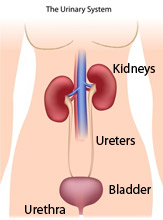MRSA Urinary Tract Infection: Risks, Facts, Symptoms & More

Most MRSA UTI infections happen when the bacteria move into the urethra or bladder.
A MRSA UTI (or urinary tract infection) is when MRSA bacteria travel up into the urethra and then into the bladder where urine is stored. For men, the prostate may also be involved. Less commonly, infection can also spread further upward from the bladder into the ureter and the kidneys.
While the majority of MRSA bladder infections start at the urethra (where urine is voided) and work their way upward, it’s also possible for infections to move into the kidneys or bladder from other body locations (such as from bloodstream infections that move MRSA from one location to another).
A note on Staph vs. MRSA: Many also get a Staph aureus or Staph UTI. Staph aureus is the non-antibiotic resistant (or less antibiotic resistant) form of MRSA and usually responds better to antibiotics. The information below is also applicable to Staph urinary tract infections.
How do you get a MRSA urine infection?
While most UTI’s are caused by E. coli bacteria which originate in the intestines, MRSA is becoming a more frequent cause of bladder infections. This is most likely because the rate of MRSA colonization is increasing and many people with active infections get boils or breakout areas in their groin or buttocks which then spreads the bacteria to the urethra. People have also reported bladder infections after lower abdominal surgeries. MRSA UTIs are most common for people who’ve had a urinary catheter, such as during hospital treatment or for those with bladder control issues like the elderly.
MRSA bacteria live on the skin of 1-10% of the population without causing infection. The bacteria like warm, moist environments, such as the nose, arm pits and genital area. Hands spread these bacteria around very easily, that’s why good hygiene is important to prevent the spread of MRSA, especially to the urethra area when using the bathroom. While catheters are the biggest cause of moving MRSA into the urethra, UTIs can also be caused by people who are colonized or infected and use the bathroom without first washing their hands.
It’s important to address UTIs because if left unchecked, they can travel into the kidneys and bloodstream causing life-threatening infections.
UTI risk factors and symptoms
Risk factors for these UTIs include hospitalization, catheter use, the elderly, institutionalized people in nursing homes or other long-term care facilities, and chronic antibiotic use. Symptoms can include the following:
- Painful burning sensation when urinating
- Frequent urination and a desire to keep going, even after you’ve emptied your bladder
- Lower abdomen pain, discomfort or pressure
- Lower back or pelvic pain
- Urinary incontinence
- Bloody or cloudy urine
- Fever, chills, nausea (usually with more severe or complicated infections, be sure to seek medical assistance)
It’s important to note that the elderly frequently get UTI infections and may not exhibit these symptoms.
Are UTI’s contagious? Precautions and prevention tips

If you’re a carrier or infected, washing your hands before using the bathroom can help prevent getting a MRSA bladder infection.
If you have MRSA in your urine, you should consider yourself contagious. MRSA bacteria are contagious and are mostly spread by touch. They cause infection after they get INTO the body, typically through skin abrasions. So, if urine that has MRSA bacteria gets onto an open wound or cut, then it is possible to get a skin infection. Or if you use the restroom and don’t wash your hands and touch others, you can transfer the bacteria to others and possibly cause infection.
Precautions if you’re infected: Good hygiene is very important and wearing gloves in certain instances will help prevent the spread of MRSA. Use them when handling urine, going to the bathroom and certainly if you’re using catheters. Cleaning toilets, handles and bathroom sink areas and good hand washing are important. It’s also best to abstain from sex during an active infection.
If someone else is infected: Again, good hygiene. Wear gloves if you are helping with urinals, catheter bags, urine disposal, or catheters. Be aware that surfaces may be contaminated and wash hands after touching any surface and visiting others who are infected. More here on cleaning and prevention.
General prevention: If you are a MRSA or Staph carrier, wash your hands BEFORE using the bathroom as you can pass these bacteria to the urethra, potentially giving yourself a bladder infection. Also wash your hands after using the restroom or if you’re around others who have a MRSA infection, UTI or otherwise.
How do you know if you have MRSA in your urine?

A urine culture and sensitivity test is best to ensure antibiotics will work against your particular strain of MRSA.
If you’re not sure if you have MRSA in your urine, a simple urine test at your doctor’s office will determine if your symptoms are due to MRSA or another type of infection.
Urinalysis: This is the typical test that is performed that looks at urine color and clarity and may also include a microscopic evaluation to look for bacteria and/or red and white blood cell counts. However, this test alone will not confirm if you have MRSA.
Urine Culture and Sensitivity: This is the most reliable way to determine if you have an infection. It’s important to ask for a urine culture test to determine what exact bacteria that is causing the infection. It’s also very important to get a sensitivity test performed, as this tells the doctor which antibiotic to choose based upon if it works or not against your strain of MRSA.
Unfortunately, many clinics will prescribe an antibiotic based upon symptoms alone. This increases your chance for developing an even more resistant strain of MRSA. Be sure to get the appropriate tests done. Find more details on getting tested here.
Current treatment options for Staph and MRSA UTIs
Click here to find out about current antibiotic and natural therapy options.
Other Helpful Resources:
Find a Urologist through the Urology Care Foundation: https://www.urologyhealth.org/urology/findurologist.cfm
MRSA UTI Prevention in Nursing Homes, Assisted Living Today: https://assistedlivingtoday.com/2012/06/5-factors-to-developing-mrsa-uti/
References:
1. Urinary tract infections, www.healthcentral.com
2. Uncomplicated Urinary Tract Infections: A Focus on Women’s Health, 2012, https://www.uspharmacist.com/content/c/36643/#sthash.qqLXN2Ka.dpuf
3. MRSA in the Elderly, April 4 2013, https://www.aplaceformom.com/senior-care-resources/articles/mrsa-in-the-elderly









